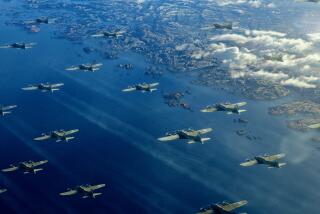âPerfect Stormâ Rains Attention on Heroes
WESTHAMPTON BEACH, N.Y. â Lt. Col. Graham Buschor narrates a story with the same attention to detail he relies on when mapping out treacherous helicopter rescue missions, the missions he and his fellow Air National Guardsmen risk their lives on but like to call âsporty.â
Buschor is recounting one sporty mission to save a man lost at sea. His audience is a sailing club, and the members are rapt, cackling at Buschorâs jokes but barely breathing at the intense points, not wanting to move and make their chairs creak.
The helicopter heâs piloting in the story runs out of fuel and ditches in the Atlantic Ocean. In the end, one of Buschorâs fellow guardsmen, a parajumper, is never found.
âItâs hard,â Buschor, 38, says haltingly. Still, he adds, âthis is what we do for a living.â
For years, the members of the 106th Rescue Wing of the New York Air National Guard have done their work pretty much anonymously out of a tiny airfield in Westhampton Beach. But now they are stars. The new film âThe Perfect Stormâ recounts a true tale of their exploits.
The movie, based on the best-selling book of the same title, documents the wicked marriage of storms along the East Coast that left a trail of death and destruction in 1991.
The 106th, home to 850 full- and part-time Air National Guard members, also helped in searches for the remains of TWA Flight 800 in 1996 and John F. Kennedy Jr.âs private plane last year.
This isnât a group of weekend warriors. A quarter are full-time Guard members, and many part-timers spend at least a day per week at the base, some as much as 130 days a year.
âWe train and train and train,â Buschor said. âIt gets boring, but it becomes apparent why you do it when youâre on a mission.â
At least 287 civilians owe their lives to the 106th since 1975, and that doesnât count saves made in combat. The squad has flown its HH-60 Pave Hawk helicopters and an accompanying C-130 refueling plane into enemy territory to save downed fighter pilots.
The Long Island base began as a flying club and became the 394th Bomb Group during World War II. Pilots from the 394th received a French medal, the Croix de Guerre with Palm, for participating in the Normandy invasion.
Today itâs one of three Air National Guard units conducting civilian rescues; the others are in California and Alaska. Generally the Coast Guard does water rescues, and forest rangers handle lost mountaineers.
Inevitably, the success of the mission comes down to the parajumpers, known as PJs.
The men--under military regulations no women can be PJs--enroll in a two-year program aptly known as âSuperman University.â
Within 12 weeks, the original class of about 100 gets pared down to 10 or 15, each striving to wear a graduateâs maroon beret. Candidates--some of whom already have been Navy Seals or Army Rangers--are tested to the point of exhaustion, then pushed still harder.
One test: Candidates must repeatedly swim 50 meters underwater. About 30 meters in, an instructor âharassesâ the swimmer, grabbing him, pulling on his mask, even striking him. Swimmers can break the waterâs surface once during the testing; a second time and the candidate is ejected from the program.
Sometimes swimmers refuse to acknowledge their need to breathe. Eventually the body tries to protect itself and prevent water from entering the lungs. An involuntary reflex constricts the esophagus, knocking the person out. Unconscious swimmers are yanked from the water and resuscitated with oxygen.
âYou look for a guy like that,â said PJ Ken Smith, 32. âThatâs a sign of mind over matter, of having a strong heart.â
PJs also learn to jump from planes--sometimes under extreme conditions like leaping from 30,000 feet and pulling the rip cord at 3,000 so they slip under enemy radar--and learn to perform medical procedures, such as inserting chest tubes and conducting field amputations. They train for mountain and desert rescues.
Then comes the true test: real missions.
Buschor described one undertaking, a 15-hour, 1,600-mile adventure off Nova Scotia, which set an unofficial record for the longest unplanned helicopter flight. A freighter sank, putting 30 sailors into the sea. By the time the helicopter arrived, sharks had killed nearly all, but the crew saved one man (a second was saved by a passing ship).
âItâs something special to pick someone up who is in trouble and bring them back to their families,â said Lt. Col. Mike Canders, a 44-year-old helicopter pilot with the squad who is credited with 10 saves.
Through it all the squad members work together, and they play hard together. Summer barbecues are frequent, and someone is always around to share a beer. Thereâs always a shoulder to lean on in case of marital strife, family woes or just plain depression.
âThe guys I feel closest to are the para-rescuemen out here,â said Smith, 32, who also is on the New York Police Departmentâs scuba team. âWe can all share something no one else can.â
On Oct. 30, 1991, those bonds were put to a fierce test during what became known as âThe Perfect Storm,â a-once-in-a-century norâeaster that forced several vessels to issue distress calls. One was the Andrea Gail, a 75-foot commercial fishing boat that eventually sank, drowning everyone on board.
Author Sebastian Junger focused on the Andrea Gail but also wrote about a helicopter from the 106th known as Jolly 110, which was co-piloted by Buschor. The crew was returning home at night after being unable to get a sailor off his boat when the Jolly 110 encountered 100 mph winds that made it impossible to refuel with the C-130. Realizing that the helicopter wouldnât make it back, pilot Dave Ruvola decided to ditch, and Buschor issued the mayday call.
PJs Arden âRickâ Smith and John Spillane, along with Buschor, leaped into a sea where some waves reached 100 feet. Ruvola, along with engineer Jim Mioli, remained on board to set the aircraft down. Both escaped from the sinking helicopter.
Buschor wound up on his own. Somehow, in the pitch darkness and earsplitting winds, Ruvola, Mioli and Spillane found one another. They were in bad shape; Spillane had several broken bones, and Mioli had no survival suit.
âThe wind is howling. Youâre getting hammered by waves every few minutes. Youâre swallowing gallons of water, which makes you vomit and then get the dry heaves,â said Buschor.
Four hours after they went into the ocean, a search plane spotted Buschorâs emergency strobe light. Soon after, a 205-foot Coast Guard cutter, the Tamaroa, found Buschor being tossed like a toy by the waves.
Coast Guard volunteers pulled him aboard. Ruvola, Mioli and Spillane came out about an hour later.
For weeks, scores of aircraft and ships scoured the ocean but never found Rick Smith. Many speculate that he leaped from about 70 feet, landing between waves because he couldnât see the turbulent ocean.
The death was the first for the unit during a mission. Three members were killed while training years earlier when a helicopter flew into a mountain.
An Air Force review of the Jolly 110 mission found the crew wasnât at fault. Some minor protocol changes were made, but the main improvement came from a technical advance. Now pilots use the Internet to check weather patterns; before, they waited for faxes of weather reports.
One thing that has not changed is the 106thâs motto, printed on a mural in the PJsâ locker room. It says:
âSo that others may live.â
More to Read
Only good movies
Get the Indie Focus newsletter, Mark Olsen's weekly guide to the world of cinema.
You may occasionally receive promotional content from the Los Angeles Times.









